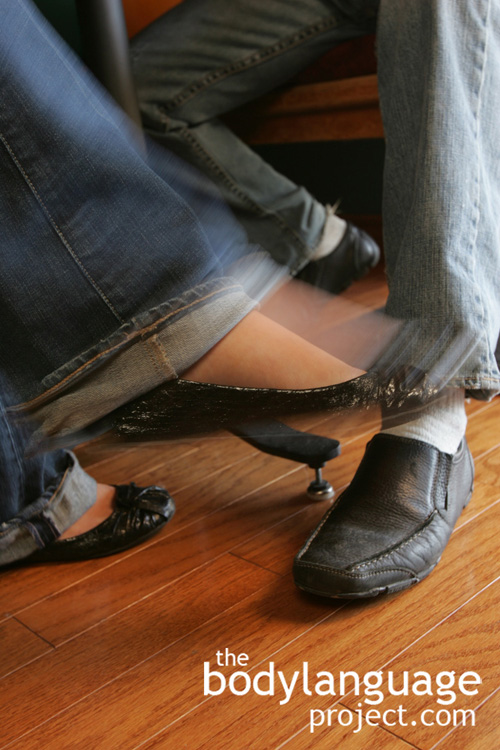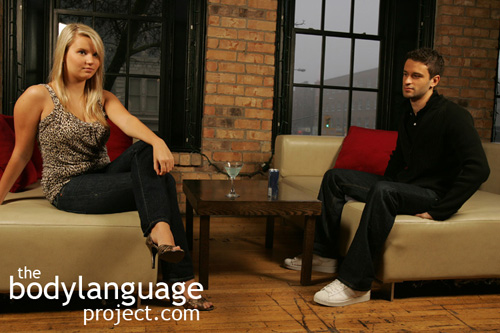Body Language of Pupillary Reflex, Pupil Dilation or Pupillary Constriction
Synonym(s): Pupillometrics, Pupillary Constriction.
Description: The pupils of the eyes (the dark part of the eye) expand or contract dependent on the level of arousal. The pupils will automatically open up and allow more light into the eye on arousal or if we see something we like. Conversely, they will contract or close when we see things we don’t like. The pupils also respond automatically to changes in light. They open when it’s dark and close when it’s bright. This protects our eye from harm and increases our ability to see as the level of light changes.
In One Sentence: The papillary reflex refers to the dilation of the pupils in response to arousal.
How To Use it: Pupils react autonomically to light and emotion, thus it is not something that can be consciously controlled. However, one might artificially create situations which control the size of the pupil. For example, to create wide attractive pupils simply set up dates in low lighting conditions. Candlelight, for example will cause the pupils to dilate, thus making them more attractive. Women can make their eyes more dreamy in profile photos by digitally enhancing the size of their pupils. Likewise, matching your desires to reality will cause eyes to dilate naturally. In other words, finding a correct dating match, which really creates excitement, will naturally produce eyes that dilate, thus compounding the attraction effects.
Context: a) General b) Dating.
Verbal Translation: “When I’m aroused or when I like what I’m seeing, my pupils dilate and open wide so I can take it all in. When I’m turned off, or it’s bright, my pupils contract and take in less light.”
Variant: See Bedroom Eyes or Dialated Pupils.
Cue In Action: a) Mom’s eyes dilated to the max as she watched her newborn baby. a) During poker, he hit the card he liked and his eyes dilated widely, fortunately he wore sunglasses protecting them from sight. b) Her eyes dilated as she observed her muscularly sculpted boyfriend undress.
Meaning and/or Motivation: Pupillometrics is the study of pupil size in relation to emotion such as liking, interest, fear and dislike. Research has shown that young children have larger pupils than adults. This is probably a way for kids to appear more attractive and gain favour and attention. Watch how cartoonist’s habitually embellish the eyes of their characters to make them more appealing.
Pupil dilation can help a body language reader assess when emotion is taking place. Under stress or arousal of any kind, be it liking or visceral disliking, the pupils expand to permit more light to enter facilitating vision. This can include stress and fear due to lying, any other fearful situation and even attraction.
Conversely, the eyes contract due to not liking. This is an entirely autonomic process and not consciously controlled. When assessing someone on their pupil size, be sure to account for changes in ambient light, as the pupils will also respond to these changes.
Cue Cluster: Watch for congruency in body language to determine the meaning behind the pupillary reflex. Liking (dilation) would be coupled with head tilted to the side, open and relaxed facial expressions, smiling and loose body language. Disliking (contraction) would be coupled with head on, hard eyes, pursed lips, grimacing, eyebrows coming together and so forth. Also watch for changes in ambient light which will also determine the meaning behind the pupils.
Body Language Category: Amplifier, Arousal, Autonomic signal, Buy signals, Courtship display, Dislike (nonverbal), Emotional body language, Eye Language, Excited body language, Indicators of disinterest (IOD), Indicator of interest (IoI), Indicators of sexual disinterest (IOsD), Indicators of sexual interest (IOsI), Leaked or involuntary body language, Liking, Microexpressions.
Resources:
Ariel, Robert and Castel, Alan. Eyes wide open: enhanced pupil dilation when selectively studying important information. Experimental Brain Research, 2014. 232(1):.337-344.
Ahern S, Beatty J (1979) Pupillary responses during information processing vary with scholastic aptitude test scores. Science 205:1289–1292
Adolphs, Ralph A. 2006. Landmark study finds that when we look at sad faces, the size of the pupil we look at influences the size of our own pupil Social Cognitive and Affective Neuroscience. 1(1): 3-4
Aranguren, Martin. “Nonverbal interaction patterns in the Delhi Metro: interrogative looks and play-faces in the management of interpersonal distance.” Interaction Studies. 2016. 16(1) forthcoming.
http://bodylanguageproject.com/articles/seriously-stop-touching-use-nonverbal-signaling-manage-unwanted-touching-busy-public-areas
Aranguren, Martin and Stephane Tonnelat. Emotional Transactions in the Paris Subway: Combining Naturalistic Videotaping, Objective Facial Coding and Sequential Analysis in the Study of Nonverbal Emotional Behavior. Journal of Nonverbal Behavior. 2014. 38:495–521. DOI 10.1007/s10919-014-0193-1
Beatty J (1982) Task-evoked pupillary responses, processing load, and the structure of processing resources. Psychol Bull 91:276–292
Bijleveld E, Custers R, Aarts H (2009) The unconscious eye opener: pupil size reveals strategic recruitment of resources upon presentation of subliminal reward cues. Psychol Sci 20:1313–1315
Bradley MM, Miccoli L, Escrig MA, Lang PJ (2008) The pupil as a measure of emotional arousal and autonomic activation. Psychophysiology 45: 602–607.
Daniel J. Kruger and Jory S. Piglowski. The Effect of Eyelid Constriction on Perceptions of Mating Strategy: Beware of the Squinty-Eyed Guy! Personality and Individual Differences. 2012. 52: 576-580.
http://bodylanguageproject.com/articles/beware-squinty-eyed-guy-studying-body-language-narrowed-eyes
Daniel H. Lee, Reza Mirza, John G. Flanagan and Adam K. Anderson. Optical Origins of Opposing Facial Expression Actions. Psychological Science published online 24 January 2014 DOI: 10.1177/0956797613514451
http://bodylanguageproject.com/articles/eyes-and-facial-expressions-may-be-biologically-controlled-serve-a-real-non-emotional-purpose-says-research/
Daniele Marzoli, Mariagrazia Custodero, Alessandra Pagliara, and Luca Tommasi. Sun-Induced Frowning Fosters Aggressive Feelings. Cognition And Emotion. 2013; 27 (8): 1513-1521.
http://bodylanguageproject.com/articles/the-sun-can-produce-feelings-of-anger-and-aggression-it-makes-us-frown/
Ekman, P., O’Sullivan, M., & Matsumoto, D. (1991a). Confusions about context in the judgment of facial expression: A reply to “The contempt expression and the relativity thesis.”. Motivation & Emotion, 15(2), 169-176.
Ekman, P., O’Sullivan, M., & Matsumoto, D. (1991b). Contradictions in the study of contempt: What’s it all about? Reply to Russell. Motivation & Emotion, 15(4), 293-296.
Girard, Jeffrey M.; Jeffrey F. Cohna; Mohammad H.Mahoor S.; Mohammad Mavadati;
Zakia Hammal; and Dean P. Rosenwalda. Nonverbal Social Withdrawal In Depression: Evidence From Manual And Automatic Analyses. Image and Vision Computing. 2013.
http://bodylanguageproject.com/articles/body-language-signals-withdrawal-depression
Geangu, Elena; Petra Hauf; Rishi Bhardwaj and Wolfram Bentz. Infant Pupil Diameter Changes in Response to Others’ Positive and Negative Emotions. 2011. PLoS ONE 6(11): e27132. doi:10.1371/journal.pone.0027132
http://bodylanguageproject.com/articles/distress-happiness-reflected-infants-eyes/
Goldinger SD, Papesh MH (2012) Pupil Dilation Reflects the Creation and Retrieval of Memories. Current Directions in Psychological Science 21: 90–95.
Heaver B, Hutton SB (2011) Keeping an eye on the truth? Pupil size changes associated with recognition memory. Memory 19: 398–405.
Hoeks B, Levelt W (1993) Pupillary dilation as a measure of attention: A quantitative system analysis. Behav Res Methods 25:16–26.
Hamel, R. F (1974). Female subjective and pupillary reactions to nude male and female figures. Journal of Psychology. 87: 171-175.
Harrison, Neil A.; Wilson, C. Ellie; Critchley, Hugo D. 2007. Processing of observed pupil size modulates perception of sadness and predicts empathy. Emotion. 7(4): 724-729.
Hess, E. H., & Polt, J. M. (1960). Pupil size as related to the interest value of visual stimuli. Science, 132: 349-350.
Hess, E. H. 1965. Attitude and pupil size. Scientific American, 212 (4): 46–54.
Hess, E. H. 1975. The role of pupil size in communication. Scientific American. 233(5): 110–119.
Janisse, Michel Pierre. 1973. Pupil Size and Affect: A Critical Review of the Literature Since 1960. Canadian Psychologist Psychologie Canadienne. 14(4): 311-329.
Marzoli, Daniele; Mariagrazia Custodero; Alessandra Pagliara and Luca Tommasi. Sun-Induced Frowning Fosters Aggressive Feelings. Cognition And Emotion. 2013; 27 (8): 1513-1521. http://bodylanguageproject.com/articles/avoid-anger-sunny-days/
Otero SC, Weekes BS, Hutton SB (2011) Pupil size changes during recognition. memory. Psychophysiology 48: 1346–1353.
Reed, Lawrence Ian; Katharine N. Zeglen and Karen L. Schmidt. Facial Expressions as Honest Signals of Cooperative Intent in a One-Shot Anonymous Prisoner’s Dilemma Game. Evolution and Human Behavior. 2012. 33: 200-209. http://bodylanguageproject.com/articles/body-language-signals-withdrawal-depression/
Rieger, Gerulf ; Savin-Williams, Ritch C Kemp, Andrew H. (Editor). The Eyes Have It: Sex and Sexual Orientation Differences in Pupil Dilation Patterns (The Eyes Have It). PLoS ONE, 2012, Vol.7(8), p.e40256.
Privitera CM, Renninger LW, Carney T, Klein S, Aguilar M (2010) Pupil dilation during visual target detection. J Vis 10(10):3.
Steinhauer SR, Siegle GJ, Condray R, Pless M (2004) Sympathetic and parasympathetic innervation of pupillary dilation during sustained processing. International Journal of Psychophysiology 52: 77–86.
Tombs, Selina; Silverman, Irwin 2004. Pupillometry: A sexual selection approach. Evolution and Human Behavior. 25(4): 221-228.
Weisfeld, Glenn E. and Jody M. Beresford. Erectness of Posture as an Indicator of Dominance or Success in Humans. Motivation and Emotion. 1982. 6(2): 113-130.
http://bodylanguageproject.com/articles/body-language-cues-dominance-submission-children/
Wierda , Stefan M.; Van Rijn; Hedderik; Taatgen; Niels A.; Martens, Sander. Pupil dilation deconvolution reveals the dynamics of attention at high temporal resolution. Proceedings of the National Academy of Sciences of the United States of America, 2012. Vol.109(22): 8456-8460.
Wang, Joseph Tao-yi ; Spezio, Michael ; Camerer, Colin F. Pinocchio’s Pupil: Using Eyetracking and Pupil Dilation to Understand Truth Telling and Deception in Sender-Receiver Games. American Economic Review, 2010. 100(3): 984-1007
Raul, Muresan. Pupil dilation and visual object recognition. Frontiers in Human Neuroscience, 2011, Vol.5.
Zellin, Martina; Pannekamp, Ann; Toepel, Ulrike; van der Meer, Elke. In the eye of the listener: Pupil dilation elucidates discourse processing. International Journal of Psychophysiology, 2011, Vol.81(3): 133-141.



